December 28, 2017 / by howard / 13,624 Comments / Filed under Blog
Day 6 – Summit attempt via Stella Point (5752 m/18871 ft) to Uhuru Peak (5895 m/19340 ft) and descent to Millenium Camp (3820 m/12530 ft) (or to Mweka Hut)
Walking distance: 5 km/3 miles ascent + 10 km/6.2 miles descent
Walking time: 5-6 hrs + 1-2 hours up, 5-6 hours down (the overall walking time may vary from 10 – 16 hours)
Altitude gain: 1072 m/ 3511 ft (Stella Point) or 1215 m/3980 ft (Uhuru Peak)
Descent: 2075 m/6810 f

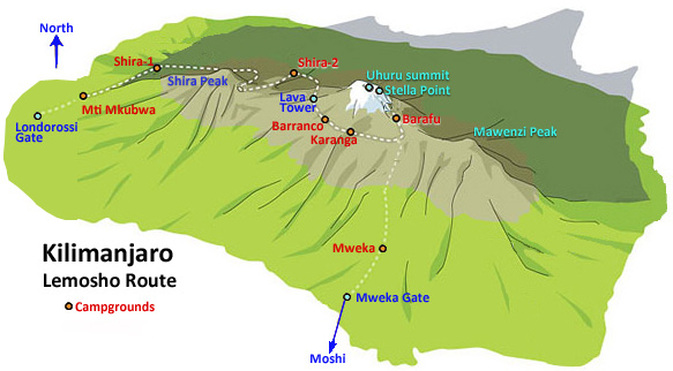
As I said yesterday, “Expect the unexpected.” We’ve learned this many times over. As much as you prepare, until you’re there in the moment, you never know what will happen. With that said, here is what happened today as best as I can piece together. I know that Howard will complete this blog with an update of his own upon his return.
Before bed, they prepared their day packs with everything they would need: rain gear, enough water, hand warmers, balaclava… The day will likely go down as one of the most physically challenging days in their whole lives.
They got up early and left at 5:00 AM to attempt the summit. After an initial little scramble over some small cliffs to get out of the Barafu Camp, the path became easier to follow. But it didn’t take long until they reached a sharp turn to the left. And then it started, the endless succession of switchbacks, snaking back and forth, back and forth, up the steep slope of loose, volcanic scree that is the side of Kibo Peak.
A guide describes it as follows:
“As steep as the slope is, due to the many switchbacks the path itself isn’t all that bad. However, the scree is lose and you keep sliding down, and nothing’s easy without oxygen. The air is incredibly thin, getting thinner all the time. You may feel horrible. Don’t push yourself too hard. Take all the time you need and for goodness sake don’t let anyone pressure you into moving faster than you feel comfortable to. Steady, steady, one tiny little step after the other. It doesn’t matter if you reach Uhuru Peak or even the rim in time for sunrise. It only matters that you reach it and that you will be able to get back down safely! You can not move too slowly on Kilimanjaro. The people who do not feel the effects of the altitude are few and far between. Hopefully the worst you have to deal with is a headache and the occasional wave of nausea. Throwing up is not as uncommon as you might hope and is no reason for concern. It’s only awful. It’s impossible to have long breaks in these temperatures. The cold starts creeping into your hands and feet first, then into your whole body. When you cross a frozen stream and notice some boulders you are very close! It’s about 30 minutes to the rim from here, but that last bit of slope is cruel, the steepest and hardest part of the whole night…The more time you spend at this extreme altitude, the more you will feel it. The path rises steadily. It may not look steep, but by now every step uphill can be a battle.”
Howard has been moving slower so the kids moved ahead with George and their assistant guide. Max, Ben and Shayna were about 800 feet ahead of Howard when Max began to feel altitude sickness. Being an intelligent young man he chose himself to descend and when he got to where Howard and Steve were they decided to escort him down so once again, Howard, at the very end, gave up his opportunity to summit because he is an amazing father.
Meanwhile, Ben, Shayna and George continued to ascend toward Uhuru Point. At about 18,500 ft. Shayna experienced a very bad headache (probably due to the altitude) and when it continued to worsen the higher they climbed, Ben (because he’s an awesome brother and a smart young man) made the decision to abort the climb entirely and take Shayna back down. I believe they reached Stella Point which means that technically they will get a certificate because this is considered the 2nd highest summit.
Meanwhile, the descent is no picnic either.
The guide describes the descent:
“You probably don’t have the tiniest little bit of energy left now. Well, guess what? The day has only begun and it’s another long day…You now have to drag yourself back down. From Stella Point it’s nearly 1100 m down, down, down… Until you get back to Barafu. The descent is cruel on the knees and you will appreciate the walking poles! If you scree run then this isn’t too bad. It’s actually quite fun. And fast! But pity those who have to stagger back down the same way they came up, switchback for painful switchback. You just want to collapse and sleep. But after what you have done to your body today it is not safe to remain at this altitude. You have no choice but to keep going. Down and down you go, for several more hours, to Millenium Camp or Mweka Huts, whichever your tour company chose. What will happen now is something of a miracle. Because as you descend further there will be air again. Oxygen! Lots of it! Oxygen is life and that is exactly what will be injected back into you. You may not believe this now, but there is a good chance that after this additional descent you may feel better and have more energy.”
When they called me they were all reunited at camp and literally crawling into their sleeping bags to go to bed. Tomorrow they still have a 3-4 hour hike to finish their descent and will call me when they are back at the hotel.
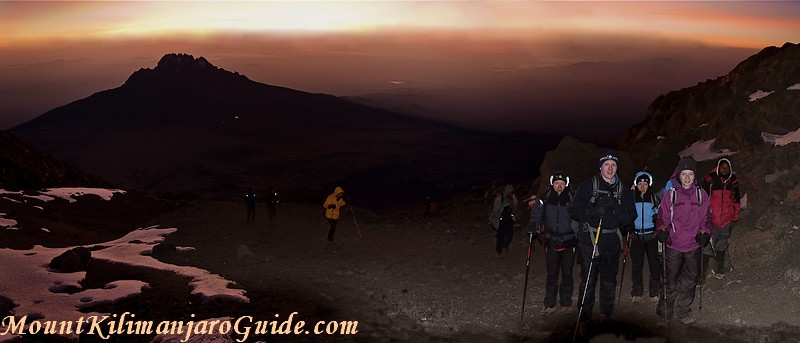 Very early morning on summit day on the Machame route. © Uta Philipp.
Very early morning on summit day on the Machame route. © Uta Philipp.
It takes most people five to six hours to reach Stella Point.
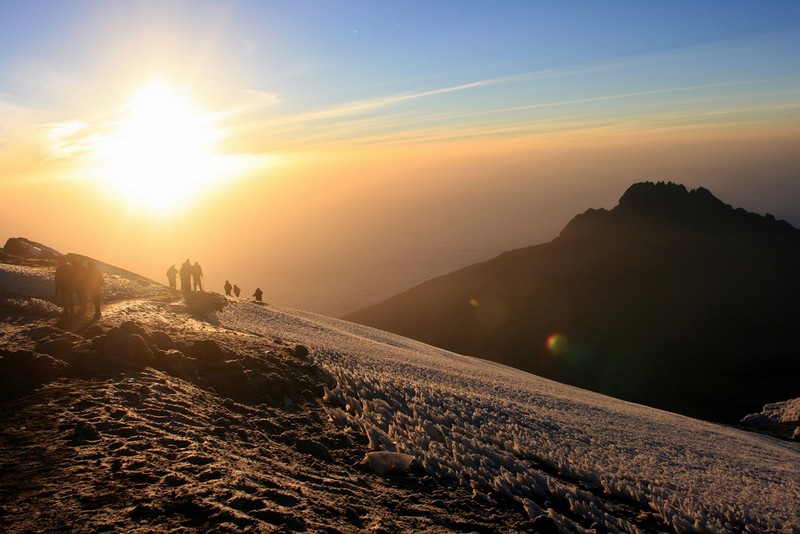 Stellar sunrise at Stella Point, photo by Abir Anwar
Stellar sunrise at Stella Point, photo by Abir AnwarTomorrow, according to the guide, should look like this:
“After breakfast you set off, down, down, down again. It’s your last day on the mountain and you may have trouble getting enthusiastic about your last hike. What you will probably notice more is the fact that the path is rather steep, and that the steps on the steepest sections are hell for your abused knees. The day takes you through some really pretty forest with lots of birdlife. Try to muster some interest. It may distract from the pain.Once you get to the gate you’ll have to endure some more formalities, but eventually you will say good bye to your guides (a sad and emotional moment), climb into the vehicle waiting for you and be whisked away to your hotel for hot showers and real beds.”
I want to sincerely congratulate my dear husband and children! What they just accomplished is truly impressive. I know how many years of training they have put in towards this. I know how they have struggled with disappointments, time to train, etc. There is no way to describe or imagine the experience of climbing to nearly 19,000 feet altitude. I am impressed with each of them together and individually for so many reasons:
Howard – I know you have been dreaming of this since you were a teenager. I am so glad that you had the opportunity to attempt this with ALL three of our children three times. I know that you had mixed emotions about going while leaving me at home but know that I have always supported you and your dreams and the way we have decided to parent together. These climbs taught our children perseverance and how to deal with disappointment and showed them that they can achieve anything they want to do. I’m sorry you didn’t get your triumphant moment but I love you so much and truly you are the best father ever!!!!
Max – I know you had to train this fall at school on your own and that you may not have chosen to do this again…but you did it to be with your sister on her attempt. I am proud of you for making the right decision for yourself when it mattered. Altitude is not something you can play with and I’m really so proud of you for deciding to come down when you could literally see the summit within reach. You traveled to Tanzania by yourself and your independence and self-confidence continue to impress me every single day.
Ben – I am always amazed by you! I know it wasn’t easy to apply for colleges, train for pole-vaulting, train for the climb and continue to ace your classes all at the same time! But then to have the responsibility for your sister on the mountain and deciding to descend at the point you did, is remarkably mature! I don’t know many adults would give that up so close to the top…but you did. You made the right decision. You chose what you needed to do which is different from what you wanted to do and believe me…there is a big difference between the two. I’m so proud of you!
Shayna – Wow!!! Stella Point! You are a rock star, my awesome daughter! I’m told the porters are all impressed by how strong you are and how you never, ever, complained…not even a little! I know how hard you worked for this and you proved you can do anything you set your mind to do! I am sooooo very proud of you! Now you get to go to Gombe National Park and see the chimpanzees!!!
Congratulations to all of you! I can’t wait to see you on Wednesday!
For all of you following this journey with us; thank you very much for your support!
Anne
December 27, 2017 / by howard / 13,227 Comments / Filed under Blog
Day 5 – Barranco Huts – Barafu Huts (4680 m/15360 ft)
Walking distance: 9 km/5.7 miles
Walking time: 9-10 hours
Altitude gain: 640 m/2105 ft
I just spoke to them and they have now reached the Barafu camp. The word “barafu” is the Swahili word for “ice”, which refers to the cold climate at this altitude. The temperature grows colder and colder as they near the summit. At this point the landscape is bleak and sparse. Barufu Camp (at 4630m) is set on an exposed ridge and is the staging point from which they will make their way to the artic summit zone tomorrow morning. Here is a photo of the sign at Barufu Camp (I don’t know these people – I google all of the photos).

Barafu Camp has an otherworldly feel to it, perched on an exposed ridge in a bleak and barren landscape. They’ve been told to familiarize themselves with the area before the sun goes down! It is quite possible to simply step of the edge if you have to stumble around in the dark to find the toilet…

An overall photo of Barafu camp:
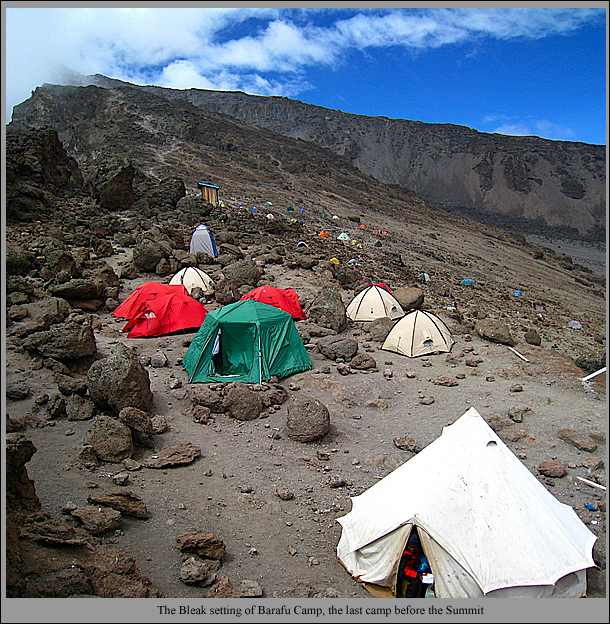
As anticipated, they had a really hard day traversing the Barranco Wall. The wall part lasted about 2 1/2 hours (remember the photos from yesterday’s update?) but the total day was 10 1/2 hours. Again Max and Ben reached camp almost two hours ahead of Howard and Shayna. According to Steve (their guide), the porters from other groups keep talking about how strong Shayna is on the trail. She’s the talk of the mountain! There are quite a lot of groups on the mountain at the same time because this is the ideal time to go and therefore Shayna has become a little bit of a celebrity sighting amongst the other groups porters.
They plan to summit tomorrow a full day ahead of schedule. This trip is hard on the body as they have now been camping multiple days, moving into higher altitudes with less and less oxygen, eating the same foods, etc. They have to drink 2-3 liters of water per day to stay hydrated. They are taking pills for malaria and altitude sickness but still…it’s strenuous.
The other day I mentioned that our friend in Israel put a note in the Western Wall for the success of their mission and a safe return home. Well, my mother and I are in New Orleans. Yesterday, we visited the famous St. Louis Cemetery Number One where the infamous voodoo queen, Marie Laveau is buried. Yesterday on the tour I learned that Louisiana Voodoo is a religious offshoot of Catholicism which is even recognized by the pope! Who knew? Anyway, there is a legend that if you leave an offering to Marie at her grave and make a wish, then the wish will come true. So I did that and I figure now they are really covered – there’s a note at the Western Wall and an offering to a Voodoo Queen.
Tomorrow morning I hope to update you with the news that all four of them successfully reached the summit together! However, a lot could still happen. As we’ve learned from the other two attempts: “Expect the unexpected.” So as you go to sleep tonight, please say a little prayer because while we sleep all night they will be attempting to summit and reach Uhuru Peak! They plan to leave Barafu Camp at 5:00 AM (8:00 PM our time).
Again, thank you for being on this journey with us!
Love,
Anne
December 26, 2017 / by howard / 9,344 Comments / Filed under Blog, Media
Day 4 – Shira Huts – via Lava Tower (4640 m/15220 ft) – Barranco Huts (3985 m/13070 ft)
Walking distance: 9 km/5.6 miles
Walking time: 6-8 hours
Altitude gain: 135 m/440 ft (790 m/2590 ft to Lava Tower)
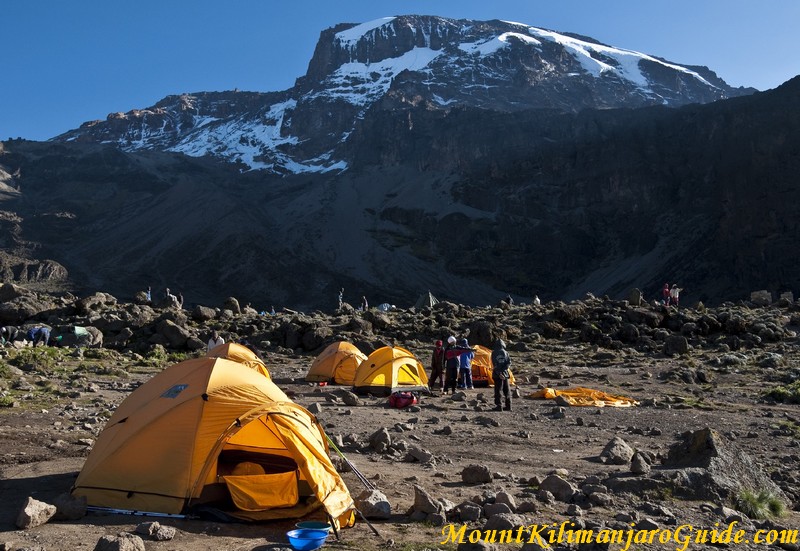
Since they camped at Shira Huts, the fourth day started with a good two and half hours of walking mostly gently uphill (and scrambling a bit for two short sections). Following the slope of the Lemosho Plateau they gradually left the heather and moorland behind and entered the mostly barren alpine desert region, enjoying breathtaking views all the way.
After some bends and ups and downs they reached the junction with the busy Machame Route. Shortly after that they came to another junction. At this point they headed towards the Lava Tower where they ate lunch.
The Lava Tower is a 100 m/300 ft volcanic plug, left over from times when Kilimanjaro was volcanic. The path towards it is a gentle slope and as they climbed towards it the short heather disappears altogether to reveal the rocky ground of the lava ridges.
The climb is often experienced as strenuous. After all, they’ve climbed up to over 4500 m and their bodies will surely notice the lack of oxygen!
After a much deserved lunch break near the Lava Tower they descended into the beautiful Barranco Valley, the result of a massive landslide some 100,000 years ago. The valley is sheltered by towering cliffs and is much greener. There is vegetation again, most notably the giant senecios and lobelias. They had great views across the plains way below and also got their first glimpse of the Barranco Wall which they will climb tomorrow…
The Barranco Camp is without a doubt the most spectacular campsite of this route, with fantastic views of Kibo, the Western Breach and the first of the southern glaciers, a fitting reward after a strenuous day. They have been quite high today, but by climbing high and sleeping low they are giving their bodies the best chances to adapt. This was an important day for acclimatization.
From this point onwards all climbers follow the same trail to the summit. They are actually planning on reaching the summit a day early! Everyone is still feeling fine physically and they are in good spirit. When I talk to them I hear a lot of laughter in the background. This time they are actually completing the whole Lemosho route as they are not doing the Western Breach. Their guide, Steve, told them that actually the last time he did the Western Breach was with them three years ago. With the glacier melting so rapidly, the Western Breach is very unsafe and therefore, it is rarely used anymore. It is estimated that within ten years there will no longer be snow on top of Mt. Kilimanjaro “the roof of Africa.”
When I spoke to them, they had just reached camp and were happy to be there. Max and Ben actually reached camp 40 minutes before Howard and Shayna. They are all ready to rest and sleep so they can continue tomorrow which is scheduled to be an exciting day as they traverse the Barranco Wall. Below are some images of the Barranco Wall. I think these photos illustrate exactly why I am not with them on this trip.
More tomorrow!
Anne
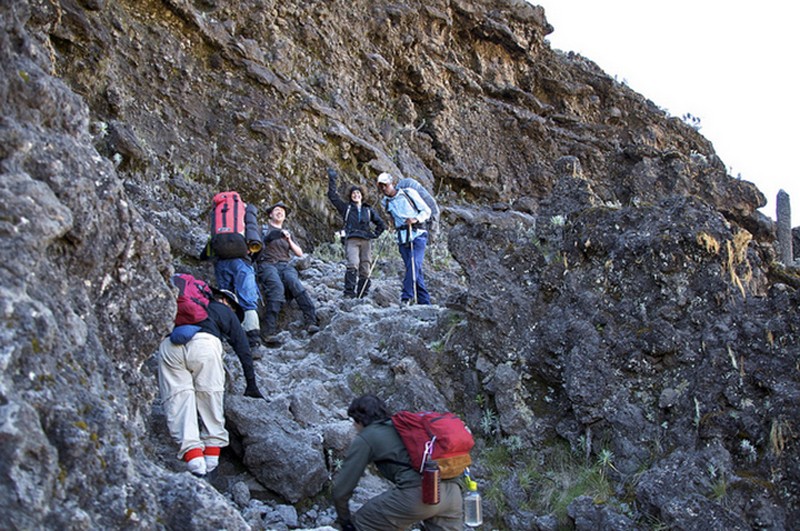
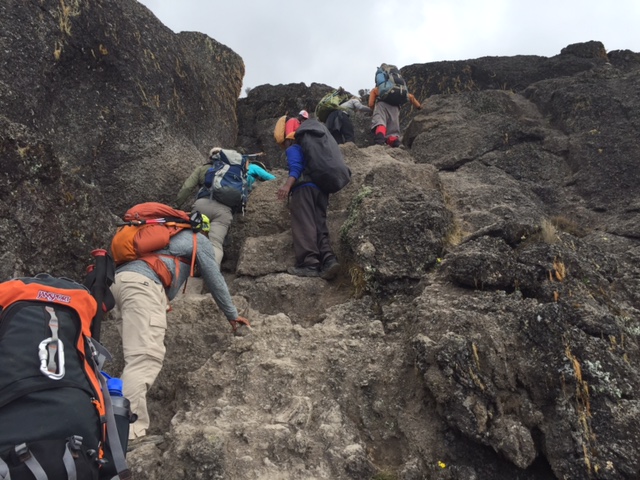

December 25, 2017 / by howard / 5,264 Comments / Filed under Blog
Day 3 – Shira I – Shira Huts (3850 m/12630 ft) via Shira Cathedral
Walking distance: 11 km/6.8 miles
Walking time: 6-8 hours
Altitude gain: 370 m/1210 ft
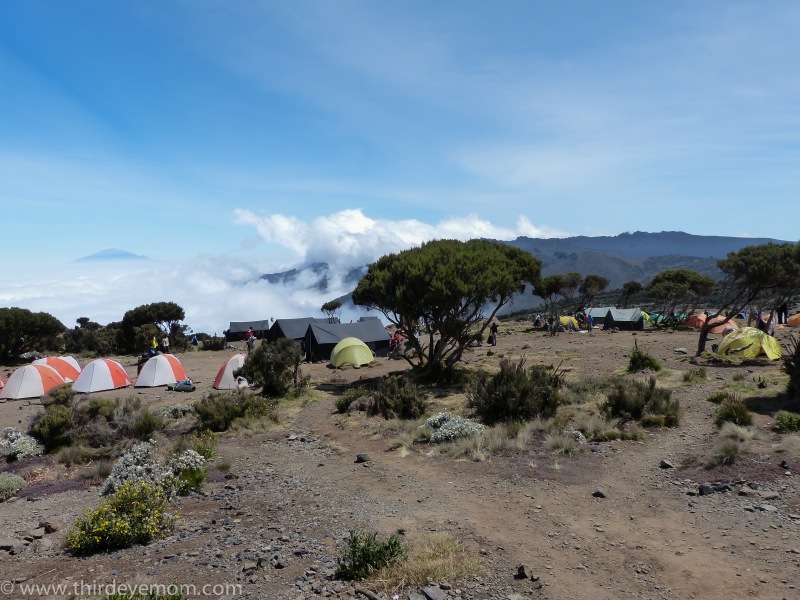
Shira II campsite
Today they walked directly across the plateau. The walk lead steadily uphill but was nowhere near as steep as yesterday. After 4 hours of hiking in they rain, they reached their final destination, the Shira Huts camps. They called me from there (7:20 AM for me, 4:20 PM for them) and everyone was in good spirits. They all feel fine and are acclimating to the altitude. Shayna is really rocking it! She was determined to do this! Tonight they are happy to have a longer rest in camp because tomorrow is a long 7-8 hour hike.
I also want to send a sincere thank you to our dear friend, Itzik Yanai, who called me from the Western Wall in Jerusalem to share that he has placed a note in the wall asking for Howard, Max, Ben and Shayna to successfully complete their journey and to come home safely. This act gives me sincere comfort. It also never ceases to amaze me that I can so easily talk to my family on Mount Kilimanjaro from a satellite phone and then an hour later talk to a friend in Israel – both from my cell phone. It’s crazy! My mother reminded me that in 1963-1964 when she lived in Paris she was able to call home once a year (on Passover) for $12 a minute. She spoke to her grandmother but her mom missed the call and was sooooo upset! I can only imagine! This has been hard for me and I’ve talked to them nearly every day – sometimes twice a day. I can’t imagine how my grandma felt missing that call.
More tomorrow…and for those of you who celebrate it! Merry Christmas!
Love,
Anne
December 23, 2017 / by howard / 4,503 Comments / Filed under Blog
Day 2 – Big Tree Camp – Shira I (3480 m/11420 ft)
Walking distance: 8 km/5 miles
Walking time: 4-5 hours
Altitude gain: 830 m/2725 ft
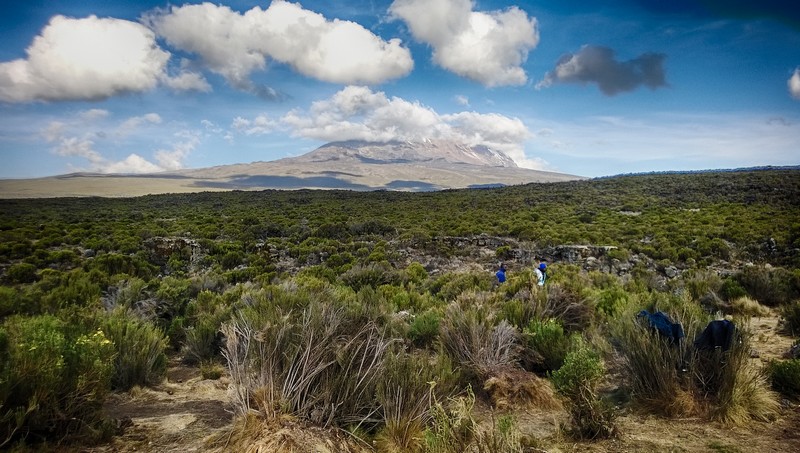
The second day may be “only” four to five hours worth of walking, but it’s not a short day. The trail is very steep today and they will take many breaks.
Once they reach the first major ridge, they leave the forest behind and enter the moorland with its giant heathers as they work their way up towards the Shira Plateau.
There are a couple more steep ridges, offering great views, and a descent in the valley on the other side.
Eventually, some time after lunch, the path flattens out. (Did I mention the path is steep?) They will be standing on the edge of the Shira Plateau at 3612 m (11840 ft): with Kibo straight ahead, the Shira Ridge to their right and they will be overlooking the plateau below.
Yes, below. It’s all downhill from here. Their next camp, Shira I, is at 3480 m (11420 ft).
Many climbers say that this is their favorite day of the walk.
If you’re wondering how I know all of this when I haven’t heard from them; its because I have researched the route. I did speak to them last night (Face Time is amazing!) while they were eating breakfast about to leave for the mountain, but since then I haven’t heard from them. I will continue to update with general information about what that day’s climb is expected to be and will let you know when I hear specifics from them. I can tell you that they are really ready and excited and already the fellas are looking scruffy with their growing beards. As I write this, they are asleep and therefore this update is really what they expect to do tonight while we are sleeping. Make sense? No? That’s ok. Just remember they are 9 hours ahead of us.
December 22, 2017 / by howard / 7,137 Comments / Filed under Blog
Hello! Today Howard, Max, Ben, and SHAYNA (for her first time) along with our good friend or as Shayna says “my other brother” George, start their 9 day climb of Mount Kilimanjaro. They have a satellite phone but communication will be spotty. I will attempt to keep you updated as best I can. They will try to call me when they camp for the night. With the 9 hour time difference, our days and nights are mixed up so they are waking up when I am going to bed. It’s kind of funny because I say “Good night.” and they say “Good morning.”
They are climbing the Lemosho route, which is the most scenic route and also the one that gives them the best opportunity to acclimate to the altitude which gives them a greater chance of success. I was informed this morning that Steve (their guide and George’s father) decided that they will do the entire Lemosho route and not diverge to do the Western Breach because Shayna’s arm length would make it very difficult for her to do the bouldering required for the Western Breach.
Lemosho is a fairly demanding route, due to both the nature of the terrain and the duration of the trail. The trail begins on the western side of the mountain. Lemosho is a narrow wilderness trail right from the beginning, passing through pristine and remote rainforest with good chances of seeing wildlife. Lemosho sees a very low number of people.
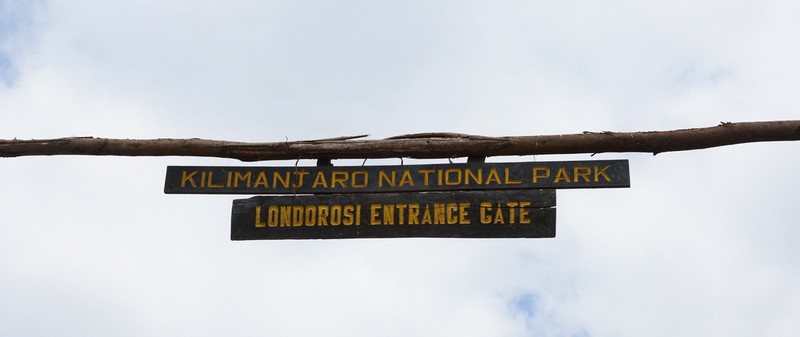
Starting Point: Londorossi Gate (2100 m/6900 ft)
Day 1 – Londorosi Gate/Lemosho trail head – Big Tree Camp (Mti Mkubwa) (2650 m/8695 ft)
Walking distance: 6 km/3.7 miles
Walking time: 2-3 hours
Altitude gain: 550 m/1795 ft
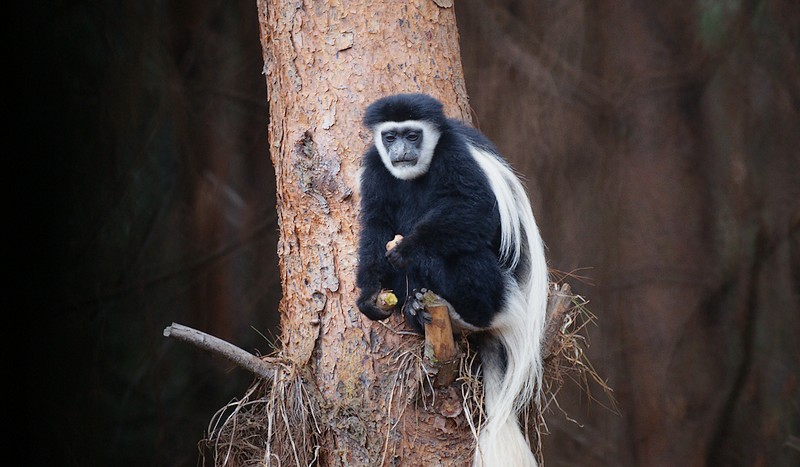
The starting point for the Lemosho Route is the Londorossi Gate. In the morning, they will drive 2 hours from Arusha to the Londorosi Entrance Gate where they will register with the park rangers. They expect to spend more time driving and waiting around at the gate than walking.
They hope to see some wildlife on the first days.
In fact, a troop of the beautiful black and white Colobus monkeys like the one in the photo above have taken up residence in the trees right next to the park ranger quarters.
After the registration at the gate they will return the way they came, about ten minutes through some fields and cypress plantations, to get to the trail head. Some call it Londorossi, some Lemosho Glades, some Simba.
They will follow the muddy road for another 20 minutes until they finally get to the real trail head.
Their trek begins in dense, misty rainforest. The forest is beautiful, like out of a fairy tale. It is full of smaller wildlife, Colobus and Blue monkeys being the most conspicuous. In the early days, shortly after the route was established, you had to be accompanied by an armed ranger here because of the water buffaloes. Today, the much larger number of climbers means bigger animals are rarely seen.
This very first day on the Lemosho Route has several steep sections to get the pump pumping, but it will only takes two to three hours for them to reach their fist campsite, the Big Tree Camp or Mti Mkubwa.
It’s a lovely camp, located, as the name says, under a big tree and with plenty of monkeys and birds around. Even if they don’t see them, they should hear them in the evenings and mornings.
People have asked me why we do this. Well, that’s not an easy answer but I’ll try:
Many years ago, Howard and I decided that we wanted to raise our children to be global citizens with an appreciation of each other’s cultures. By forming personal relationships with people outside their lived world, they can build bridges to a greater understanding of the world. To this end, today they have friends all over the world from many cultures representing different races, religions, and ways of viewing the world. We also felt that it was necessary to require them to have a purpose: a goal to strive toward where they have to learn how to persevere, to deal with disappointment and setbacks and to live a life where the concept of “Tikkun Olam” (Jewish concept of charity) was embedded into their daily lives. The Kilimanjaro climbs have accomplished just that, multiple times over. To date, they have not all successfully reached Uhuru Point (the summit). Only Ben and George did that the last time. Both Howard and Max had serious health issues on the mountain that required them to return to lower altitudes before reaching the summit. They have continued to regroup after each climb and continue training. Their training hikes kept them talking to each other and maintaining open and close relationships with us during their teen years. They have bonded uniquely with each other and George. They have impacted George’s life dramatically as we are trying to help him come to the USA for college. Shayna has never known a time when they haven’t been training and was determined to do it too. This third trip (probably Howard’s last) is her turn to go. These trips have become the topic of both boys’ college application essays. It is a hard physical challenge but it has shaped each of them in immeasurable ways which are not quantifiable but can be seen in each of their personalities. It is very possible that they would be different people today if they hadn’t focused on these climbs for the past 9 years. They are also trying to finish raising money for the Magen David Adom ambulance. This has had a life of its own and they are only halfway there. However, they’re not quitters. I am sure that eventually they will pay for the ambulance. This connects the climbs to a greater good which they are very passionate about and that is Israel. So the climb has meaning beyond just them. Which brings this to me: the non-climber in the family. Well, for the first time in 25 years, I am on my own at home, discovering who I am when I’m not defined as a wife or mother…I’m climbing my own mountain.
Thank you for joining us on this journey!
Anne
December 13, 2017 / by adam1 / 2 Comments / Filed under Blog
Dear Friends:
I am excited to be writing to you today to advise you that all of my children, including my 13‐year‐old
daughter, Shayna, and I will be returning to Tanzania to climb Mount Kilimanjaro this month. Many of you
are aware of our prior climbs and the issues and triumphs we have had with each of them. The summit of
Kilimanjaro remains an important goal of ours. However, more importantly, our Operation Climb campaign
is an even higher and much more important goal. At this time, we are almost half way toward an ambulance
with a total of $46,273.00 raised for Magen David Adom in Israel (“MDA”). This money has been raised
through the generous donations and support of our family, friends and colleagues.
I write you today to, once again, ask for your assistance in this matter. Today, more than ever, the
emergency and medical services which MDA provide are critically important, especially with the rising
tensions in Israel. MDA is an organization in Israel that responds to anyone who is sick, wounded and/or in
need of emergency services. MDA responds whether you are a Jew, Christian or Muslim; regardless of
politics.
Many of our friends have asked why we are undertaking these efforts again. Simply said, we are looking to
finish our projects. First and foremost, we are working to raise enough money to buy an ambulance for
MDA to be used in Israel. Secondly, on a much lighter note, we have our own personal goal to reach the
top of Kilimanjaro and for Benjamin to blow his shofar at the summit.
I hope that you will consider supporting us in our endeavor. All money donated goes directly to MDA. We
ask you to consider making a donation, and also ask you to talk with one or two of your own friends to
participate as well. Donations can be made in two easy manners.
You can go online to www.opclimbmda.com and click the donate section. This will bring you directly to the
designated MDA page. You can also directly call MDA’s Northbrook office at (847)509‐9802, and tell them
that you would like to make a donation that should go toward Operation Climb. It is very important that
you advise the staff that it is an Operation Climb donation, so they properly credit it to our campaign. All
donations are tax deductible.
If you would like to follow our progress on the mountain you can sign up for our Facebook page and e‐mail
list on the Operation Climb MDA website.
My family and I thank you for your support and for all of the good wishes. Please feel free to reach out to
any of us if you have any questions.
Toda Raba!
Howard M. Zavell
January 4, 2015 / by adam1 / 6,070 Comments / Filed under Blog

 Photos:
Photos: Ben at the summit and Max and I at about 17,500, resting on a ledge.
Hello Everyone,
I wanted to follow-up our adventure with a personal update from me. Now that we are home, I have had the opportunity to reflect on this amazing experience. First, I want to thank Anne for updating the blog every day, even though we gave her very little information during our brief satellite telephone calls. She did an amazing job.
I am also thankful for everyone who followed our climb. I was amazed to hear we had almost 900 followers on the different social media we utilized.
As many of you know, this was our second attempt to climb Mt. Kilimanjaro. Two years ago (after 2 years of training) and one day from the summit, we had to abort when I fell ill. The boys were extremely disappointed and I knew, if at all possible, that I needed to give them a second opportunity to summit. Thus, we continued to train. Then a year ago, Ben’s collar bone was broken in a soccer game in November which ended our plans to go last winter break. We continued to train. Finally, this year, we were able to go and give it a second try. To date, we have been in intensive training for four years.
The only other climber with us on this trip was our guide’s son, George. George is the same age as Ben (14) and he has never left Tanzania. However, he goes to school where they teach in English even though his native language is Swahili. Max and Ben met George two years ago and have kept in contact via email. During the ten days they spent together, they shared stories about their homes, the foods they eat and their religious beliefs. For instance we celebrated Hanukkah on the mountain and lit a menorah each night even at the highest elevations. The boys explained the story of Hanukkah to George. Throughout the 10 days , I heard them teaching each other words in English, Swahili and Hebrew. It was amazing to watch these three young men from completely different cultures share this life-altering experience. By the way, while George lives within 1 hour of Kilimanjaro, he has never climbed it and told me he knows of no other friend of his who has ever climbed it either.
I am pleased to tell you that Ben summited the mountain and made it all the way to Uhuru Point, 19,341 feet. This is the highest point in all of Africa. Max and I made it to Stella Point, the second highest point,at 18,885. Here is the back story.
There are about 9 routes on Kilimanjaro and they range in difficulty. However, they all converge and in the end there are only three routes to the summit. Locals have given these nicknames: Coca Cola (easiest), Whiskey (middle difficulty), and the Double Whiskey ( most difficult). The Double Whiskey route involves what is called the western breach. All other routes involve only a steep hike. I am told that the western breach is attempted by less than ten percent of all climbers and requires a special waiver form to be signed. The reason for this is because of it’s difficulty, high risk and the fact that there have been many deaths along this route. The western breach is a portion of the climb that runs from about 15,000 to 18,000 feet. It is a vertical rock face that requires a steep hike, turning to scrambling, bouldering and then rock climbing. This is all done in heavy winter gear, you start this portion of the climb at 4:30 A.M., and the temperature is about 10 degrees Fahrenheit. The western breach is also prone to high winds and rock slides. Several years ago, while camping at the camp where you start this assault, Arrow Glacier, three climbers were crushed by a rock slide.
We started our climb on what is known as the Lomosho Route. However, after three days on this route we then headed toward the western breach, rather than following the normal Lemosho route. From this point until our descent, we saw no one else. The next day brought us to Lava Tower (14,500) and also the place we turned around on our first attempt. From Lava Tower we climbed the following day to Arrow Glacier (15,500). These are both very remote. Arrow Glacier sits close to the base of the western breach. It has a strange feel to it because you sense you are sitting under the summit and are facing a vertical rock face. The winds can be very high here and as soon as it got dark, the temperature dropped quickly. We had dinner and made our final plans for our summit attempt the following day. We then climbed into our sleeping bags and tried to sleep. Around midnight I awoke to a sound I had not heard on the mountain before. It was a large rock slide. It sounded like the earth was just moving and falling. This was even stranger as it broke the silence of the quiet night.
With this background, here is how our summit day unfolded. We arose very early and at 4:30 A.M., in full winter gear with our backpacks and 7 liters of water each; we began our assault. It was very cold and as dark of a night as you have ever seen. The stars of the southern hemisphere filled the cold crisp sky. I was in awe of the night sky. The climb started with a steep hike, then turned to more of a scramble and bouldering. As we rose from 15,000 feet, a few hours later the sun came up and the ice covering many of the rocks began to melt. The plan was that the western breach would take us 4-5 hours, and then we would rest on the crater rim, eat and then make the final assault for the summit which would be another 1,000 foot steep climb. Within a few hours we began to shed some layers and were making good progress, on what was now a rock climb. Due to the nature of this section there are no harnesses or ropes to assist. Spirits were all high and we all felt that it was only a matter of time until we all made the summit. However, around 17,000 feet, Max advised me he had a slight headache. Max had these during the trip from time to time, but they were usually resolved by drinking more water. By the way, on the mountain, you need to drink between 6 – 9 liters of water a day in order to handle the altitude. So our guide and I consulted and we agreed Max would drink some water, rest for a few minutes and take some Ibuprofen.
We then pressed on. At 17,500, Max told me he was nauseous and the headache had worsened. We stopped on a rock ledge, and then Max became sick and vomited. Our guide and I consulted one another about our options. Descending along the western breach would be dangerous and would pose a high risk of falls. We agreed that finishing the breach was the only option, and at that time we could determine if Max could continue or if a rapid descent would be necessary. After being sick, Max felt better and we continued our climb up the rock face. This was very slow due to the nature of the rock face, winds, and slickness of the rocks. A 17,700, Max told me while drinking water that he wanted to close his eyes and go to sleep. This is a dangerous sign that can accompany High Altitude sickness. The problem with being at this high altitude is that the high altitude sickness can progress very quickly (as short as 1-2 hours) to a life-threatening situation (HAPE or HACE), and thus descending quickly is necessary. Due to Max’s condition it took us almost two more hours to finish the breach from this point.
We made it into the crater at about 18,300. Both the entry point to make an assault on the summit and also the location for a rapid descent require crossing the crater. The crater looks like a desert on one side and there is a glacier on the other side. As we crossed the glacier, it was like a blizzard with a hard driving snow. As we crossed the crater, Max vomited twice more. At high altitude, circumstances change very rapidly, and the wrong decision or failure to be decisive in your decision-making can lead to death quickly. Both our guide and I knew at this point that Max’s well-being and life required a rapid descent. As you cross the crater the route to the summit came first. Max and our guide wanted me to go to the summit and they would descend. Max’s condition was so dangerous, I insisted that I forgo the summit and descend with him and the guide. So I told Ben he would go to the summit with George and the assistant guide and I would descend with Max. Ben and I spoke quickly, and it was extremely emotional for both of us. I then gave him a hug and a kiss and he turned toward the summit. He disappeared into the snow within a minute and I could no longer see him.
In order to get Max down, we had to climb up and through Stella Point at 18,885 ft. In the snow we did this as quickly as possible and then began our rapid descent. This was a slope with crushed lava and we began almost a skiing action through this area. Within about 40 minutes, we had descended to about 16,500. Max ‘s color and level of consciousness were improving as we descended. I was having difficulty keeping up with them, and felt I was slowing them down. So I sent our guide and Max ahead, as I knew the faster he descended the better Max would feel and that the risk to his life would be decreased. We agreed I would wait in a small cave at 16,500 until our summit group came down and I would descend with them. Max and the guide then disappeared into the snow. About 1.5 hours later, Ben came casually walking down the mountain with a big smile on his face. By the way, he was wearing his HP winter hat! We hugged on the side of the mountain and began to descend together. We talked about his great accomplishment and shared our feelings of what has just taken place. We passed through a camp at 15,500 feet about 1.5 hours later and were told Max passed through earlier and was feeling better. He continued on to high camp at 12,500. Max knew that by going lower he would decrease his risks of an adverse outcome.
We eventually reunited with Max at high camp at 8:30 P.M. 16 hours after we started our summit attempt. Max was feeling well. The next day we finished our descent in about 8 hours and Ben received a certificate from Tanzania for reaching the highest point in Africa and Max and I each received one for reaching the second highest point.
I am so very proud of both of them. This is one of the most difficult things I have done in my life. Max and Ben never complained about the training, the route, the cold, or the long days. They were focused and embraced this with their souls. When fast decisions had to be made, they both did what had to be done. Max never gave up. He never cried. He understood that he had to finish the breach, climb even higher, and then descend as fast as possible to save his life. High altitude sickness not only is physically debilitating, but psychologically it is devastating too. When it strikes there is an overall feeling of despair that causes many people to give up and die. Max did not give up. He persevered and did what had to be done.
Ben was amazing. He was focused the entire climb. Our guide said he has never seen a boy Ben’s age be so strong both physically and emotionally. To reach the summit, you have to be willing to give 1000%. Ben did this and more, as in the end, he had to finish the last 1000 feet without us by his side. He had to climb on even when he knew Max was physically in trouble. To remain focused in this situation is unbelievable.
I titled this post “Love, Respect and Perseverance”. Early in the climb as we hiked through the foot hills of Kilimanjaro and over a plateau at 12,500 feet, which was formed when another volcano exploded millions of years ago, I had time to think about many things. What kept going through my mind over and over again is how lucky I am to have a family who embraced my dream and who agreed to live it with me…twice. In this very dangerous place, the love I share with my family made me stronger and better. Not only were Max and Ben with me, but so were Anne and Shayna.
I use the term respect for two reasons. Max and Ben were focused throughout and never lost sight of our goals. They have my respect because this was very difficult. Hiking one day or sleeping in freezing temperatures for one night is difficult, but doing it day after day is a whole different situation. The way they handled themselves on the mountain impresses me and for that and about a million other reasons, I respect them. I also use the word respect because the mountain is something which is beautiful, enormous and dangerous all at the same time. On the mountain, things change very quickly. The weather changes by the second and your body changes that quickly as well. One minute you feel great, and within minutes you feel terrible and debilitated. So for these reasons, I respect the mountain.
Finally, I use the word perseverance because that is what it takes to reach a large goal. Max and Ben have shown they have perseverance and this makes Anne and I so proud. Perseverance also comes into play with our MDA campaign. We have received a lot of support from everyone and I know that we have made good progress to our goal of purchasing an ambulance for MDA. This coming week I will obtain an update from MDA about what we have raised and will post the amount here as soon as I receive updated figures.
Finally, many people, including Anne, have asked me why we climbed the western breach and not one of the easier routes. My answer is simple. We climbed the Western Breach because we could! (Note from Anne here: I’m really glad they kept me in the dark about this. Hearing about it afterwards was scary enough.)
Thank you all so very much for your support and good wishes. And we look forward to celebrating once we reach our goal of raising enough money to purchase an ambulance for MDA.
December 22, 2014 / by adam1 / 9,929 Comments / Filed under Blog
It turns out that Mt. Kilimanjaro actually has three summits. Uhuru Peak is simply the tip top and the most famous! This is the peak Ben was able to reach. However, Howard and Max did reach a different recognized summit known as Stella Point. This means that technically all three of them successfully reached a location that is a recognized summit and received certificates of achievement when they returned to the gate to check out. While they did not get to experience the euphoria of triumphing Uhuru Peak together; all three DID SUMMIT!!!!!
The certificate looks like this:

When I spoke to them about 10:30 AM Chicago time, they had just arrived back at The African Tulip. Howard said the descent was “brutal”. I don’t yet know the details of Max’s ordeal but I do know that although the climb is technically not as challenging as when climbing the high peaks of the Himalayas or Andes, the high elevation, low temperature, and occasional high winds make this a difficult and dangerous trek. Acclimatisation is essential, and even the most experienced trekkers suffer some degree of altitude sickness. Kilimanjaro summit is well above the altitude at which high altitude pulmonary edema or high altitude cerebral edema can occur. All trekkers will suffer considerable discomfort, typically shortage of breath, hypothermia, and headaches. The average summit success rate is 66% with over 25,000 visitors attempting it annually.
The Origin of the Name
The origin of the name “Kilimanjaro” is not precisely known, but a number of theories exist. European explorers had adopted the name by 1860 and reported that “Kilimanjaro” was the mountain’s Kiswahili name. But according to the 1907 edition of The Nuttall Encyclopædia, the name of the mountain was “Kilima-Njaro” and it means “mountain of greatness”.
After four years of training, two attempts and a lot of grit, motivation and heart I am proud to say that while the journey did not meet their dream ending of standing triumphantly atop Uhuru Peak together; it met our family goals and our parenting goals. It bonded them in a way that cannot ever be taken from them! Both attempts are experiences they will never forget and along the way they reached personal goals, faced challenges, made life-altering decisions, stayed motivated; showed grit, and made friends all over the world. The “mountain of greatness” proved to be just so…but it didn’t conquer them. They conquered it…and Max and Ben are stronger young men for the experience. Nothing worthwhile ever comes easy! They have learned this and that is the best thing of all. On top of it, they raised money for a worthy cause and became global citizens with a global awareness we could not have given them sitting safely at home.
So it is that I end this daily blog. I cannot get over that this reached 894 people yesterday. It is mind-boggling! When Shayna and I went to breakfast today, half the restaurant stopped me to say “Congratulations!” or “How are they?” Incredible!
I will post again when I have stories and photos to share…or perhaps they can each post their own account of their experience. In any case, thank you for supporting our family and following this journey with us!
Sincerely,
Anne
P.S. You can still contribute to their Magen David Adom ambulance fund if you’d like!
December 21, 2014 / by adam1 / 6,020 Comments / Filed under Blog
Be the hero of your own life story. ~ Gerard Butler from WALL-E
One of my favorite quotes; it seems appropriate for today’s update. At 11:15 AM Chicago time, my phone rang. It was Howard calling from their camp at 12,500 feet. I was expecting an excited, triumphant phone call. Instead he relayed that Ben was the only one of the three of them to have successfully reached the summit. At approximately 17,500 feet Max started to experience altitude sickness. They attempted to continue but it only worsened. If you aren’t familiar with the effects of altitude sickness, I’m not going to describe it here but suffice it to say that it devastates the body and psyche of the individual and can be very dangerous! As a result, at 18,300 feet Steve and Howard chose to descend with Max. Ben and George continued on to the summit with the assistant guide. Howard felt fine but as you can imagine, he was not going to leave Max for a second. I was able to speak to Max on the phone and he sounded good. He said he was fine with not reaching the summit…and Howard said he was fine with it too.
In my eyes, they are all heroes! First, kudos to Ben for separating from them and continuing with George and reaching the summit at the age of 14!!! He did it!!! Of the 3 of them, I think that this was most important to Ben personally and so I am thrilled that he did it! I haven’t seen his photos yet but I will post them when I get them. Second, kudos to Max for recognizing that his health is most important! He’s only 17. If he wants to ever try again, he has plenty of time. Third, kudos to Howard for not only allowing Ben to go on without him but also for staying with Max (as it is likely that Howard may choose to not attempt it again.) No one can take away from them that they reached 18,300 feet!!! This is an amazing accomplishment in itself and I’m really proud of all of them! They each did the right thing for them in the moment!
And so…in the immortal words of Howard’s high school gymnastics coach and mentor, Seymour Rifkind, “Expect the unexpected” continues to be true. Tomorrow I expect to hear from them when they get back to their hotel where they will rest. They will then go see the site where Louis Leakey found the oldest known human bones. On Christmas day we will all reunite and I can’t wait!

 Very early morning on summit day on the Machame route. © Uta Philipp.
Very early morning on summit day on the Machame route. © Uta Philipp. Stellar sunrise at Stella Point, photo by Abir Anwar
Stellar sunrise at Stella Point, photo by Abir Anwar












